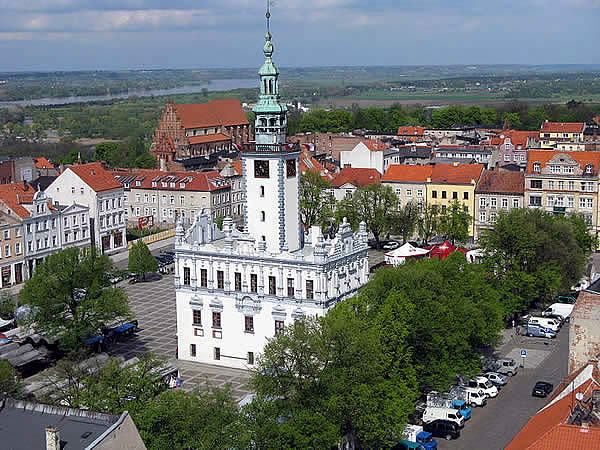Postal code 86-200 Population 20,388 (2006) | Elevation 75 m (246 ft) | |
 | ||
Weather 12°C, Wind SE at 11 km/h, 60% Humidity Points of interest Muzeum Ziemi Chełmińs, Park Miniatur Zamków, Kościół Garnizonowy, Park miejski "Nowe Pl | ||
Chełmno [ˈxɛu̯mnɔ] (older English: Culm; German: Kulm ) is a town in northern Poland near the Vistula river with 20,000 inhabitants and the historical capital of Chełmno Land. Situated in the Kuyavian-Pomeranian Voivodeship since 1999, Chełmno was previously in Toruń Voivodeship (1975–1998).
Contents
Map of Che%C5%82mno, Poland
Name
The city's name Chełmno comes from the old Polish word for hill: "chelm". After the arrival of the Teutonic Knights, the city was founded in 1232 using the Latin name Colmen. During the Middle Ages, the German name Culm was used in official documents regarding the town, as the city was a member of the Hanseatic League and part of the State of the Teutonic Order. Chełmno came under Prussian jurisdiction in 1772 and the German name Culm became again official. It was officially renamed Kulm in 1872. During the Nazi occupation in World War II, the town was again renamed from Chełmno to Kulm.
History
The first written mention of Chełmno is known from a document allegedly issued in 1065 by Duke Boleslaus of Poland for the Benedictine monastery in Mogilno. In 1226 Duke Konrad I of Masovia invited the Teutonic Knights to Chełmno Land. In 1233 Kulm was granted city rights known as "Kulm law" (renewed in 1251), the model system for over 200 Polish towns. The town grew prosperous as a member of the mercantile Hanseatic League. Kulm and Chelmno Land were part of the Teutonic Knights' state until 1466, when after the Thirteen Years' War Chełmno was incorporated into Poland and made the capital of Chełmno Voivodeship.
In 1772, following the First Partition of Poland-Lithuania, the city was taken over by the Kingdom of Prussia. Between 1807 and 1815 Chełmno was part of the Duchy of Warsaw, being reannexed by Prussia at the end of the Napoleonic Wars.
Kulm had been a garrison town. In 1776 Frederick the Great founded here a cadet school which was to serve in Germanising Polish areas and nobility In 1890 the garrison included 561 military staff. On 1 October 1890 the cadet school was moved to Köslin in Farther Pomerania.
Chełmno was given to Poland in 1920 following World War I.
When World War II broke out in 1939, Nazi German authorities murdered 5,000 Polish civilians upon taking control of the territory. The atrocities took place in Klamry, Małe Czyste, Podwiesk, Plutowo, Dąbrowa Chełmińska, and Wielkie Łunawy, while many other Poles were executed in forests. The rest of the Polish population was expelled to the General Government in line with the German policy of Lebensraum. Polish Secret State resistance groups such as Polska Żyje ("Poland Lives"), Rota, Grunwald, and Szare Szeregi were also active in the area. The area was administered as part of Reichsgau Danzig-West Prussia and served as the seat of the district/county (kreis) of Kulm.
On 25 January 1945 German forces set fire to several buildings in the city, including a hospital, a railway terminal, and a brewery, while retreating (see scorched earth).
Demographics
Since its founding, the city had a mixed population of Germans and Poles, with the latter making ⅔ of its population in the second half of the 19th century.
Main sights
Chełmno has a well-preserved medieval center, with five Gothic churches and a beautiful Renaissance town hall in the middle of the market square.
The Old Town is one of Poland's official national Historic Monuments (Pomnik historii), as designated April 20, 2005, and tracked by the National Heritage Board of Poland.
Chełmno gives its name to the protected area called Chełmno Landscape Park, which stretches along the right bank of the Vistula.
